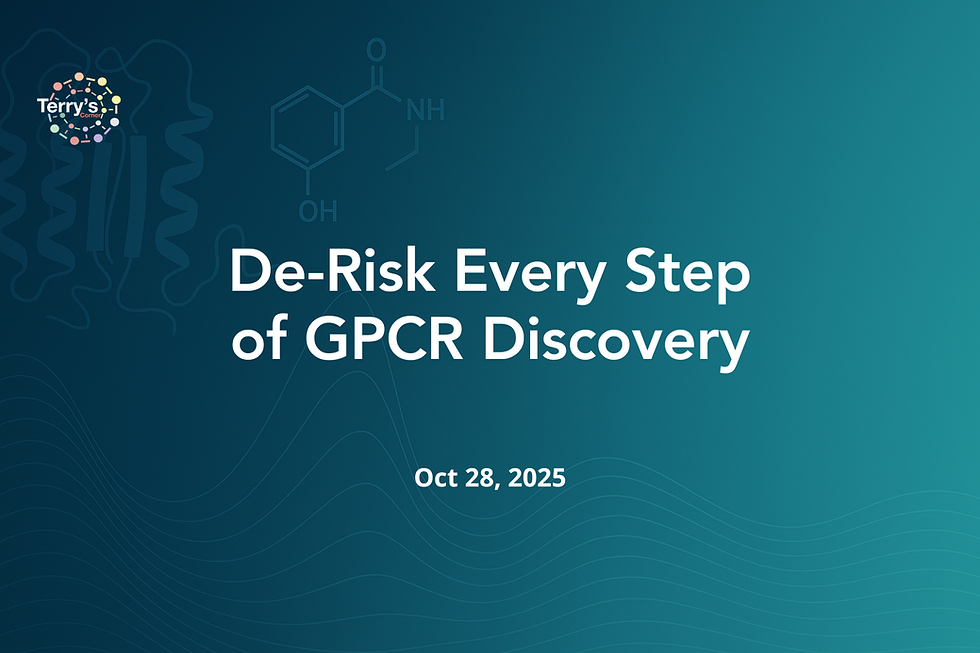Accelerating GPCR Drug Discovery: What 40 Years of Pharmacology Reveal
- Terry's Desk

- Oct 28
- 4 min read

Why Speed Matters in GPCR Drug Discovery
Nine out of ten GPCR programs stall not because the target was wrong, but because teams waited too long to test the right thing. Terry has seen this story play out for 40 years — and he’s helping rewrite the ending.
In accelerating GPCR drug discovery, the bottleneck isn’t target identification — it’s turning validated hits into real therapies fast. Attrition rates in early pharmacology remain painfully high. Molecules that look promising in vitro often unravel in vivo. Programs stall. Timelines stretch.
But what if you could navigate these bottlenecks using the field-tested decision logic of one of the most experienced pharmacologists alive?
That’s exactly what Terry’s Corner was built to do: bring four decades of frontline discovery insight straight to discovery-phase scientists and R&D strategists — without the noise, hype, or outdated models.
In this session, you’ll gain:
✅ Proven strategies to balance in vitro vs. in vivo testing early — when it matters most.
✅ Practical ways to integrate kinetics, allostery, and bias into smarter development decisions.
✅ Insider guidance on how real teams decide which GPCR programs to advance or kill.
The High Cost of Pharmacology Gaps
Every experienced drug hunter knows this: validation isn’t the problem anymore. Screening technologies, structure-informed design, and AI are accelerating target selection.
The real friction point lies downstream: translating receptor–ligand interactions into actionable development decisions. A well-behaved molecule in a dish can fail spectacularly in vivo, leaving teams with years of sunk costs and little to show for it.
Terry puts it bluntly:
“Once you have a molecule, everything boils down to pharmacology—hit, lead, candidate, drug. And the rate of attrition in these steps is still atrocious.”
Terry’s Corner is designed to shorten that distance between initial promise and actionable clarity. Scientists get frameworks, not guesswork.
Early In Vivo Wins the Race
When is the right time to move beyond cell assays? Earlier than many teams do.
“The sooner you get your molecule in vivo, the sooner you know whether anything’s happening—and whether it’s the right or wrong thing,” Kenakin emphasizes.
In vitro work is invaluable for mechanistic understanding—assay volume control, expression system contrasts, predictive pharmacology. But in vivo testing reveals the physiological truth. A smart program doesn’t wait until late stages to validate its assumptions.
GPCR Kinetics: The Critical Data You Can’t Afford to Skip
Equilibrium potency data only tells part of the story. Real systems don’t live at equilibrium.
“Target residence time in vivo correlates beautifully with activity. Potency does not,” says Kenakin.
High-throughput screens and static binding curves are easy to run, but ignoring kinetic profiling means missing the factors that often make or break clinical efficacy. Modern real-time assays can deliver these insights earlier, faster, and cheaper than most teams assume.
Kinetics isn’t an afterthought—it’s a competitive advantage.
Allostery Is Not Optional Anymore
The GPCR field is no longer a binary world of agonists and antagonists.
“GPCRs are nature’s prototype allosteric proteins. Everything they do is allosteric.”
Allosteric modulators and biased ligands aren’t exotic outliers—they’re increasingly common outcomes of modern screening. Teams that don’t understand how to detect, interpret, and exploit these mechanisms risk walking away from valuable compounds.
Kenakin reminds us: “Allostery will seek you—even if you don’t seek it.”
Antibodies, Bias, and the Expanding Modality Landscape
Antibody therapeutics are now entering spaces once dominated by small molecules. Biased antibodies and allosteric antibody modulators are no longer theoretical—they exist.
This expands the strategic toolbox for discovery teams:
Bias isn’t an “optional property” to design in later. It shows up naturally.
Allosteric antibodies can mirror or exceed small molecule complexity.
Early cross-screening can flag biased phenotypes long before animal studies.
How CRO Communication Impacts GPCR Drug Development Success
Even the best science falters without operational precision. CRO partnerships are essential for most discovery programs, but they often break down on communication.
“Scientists love to control experiments. CROs have standard ways of doing them. You must bridge that gap,” Kenakin notes.
Teams that proactively define experimental nuances early avoid receiving “perfectly executed wrong assays.” Every misaligned study is not just wasted budget—it’s lost time.
Program Kill vs. Advance: What Real Teams Do
How do large pharma teams decide whether to advance or pause a GPCR program? It’s less bureaucratic than most outsiders think.
Programs aren’t killed because of bad ideas—they’re paused when the chemical matter isn’t compelling enough or when strategic focus shifts.
“In industry, scientists bring targets forward. There’s no central committee handing down orders. Grassroots science drives the agenda.”
For scientists in discovery, this means two things:
Technical clarity drives survival.
Strategic communication drives momentum.
Key Questions Answered in this AMA Session
How early in vivo models sharpen go/no-go calls.
Why kinetic profiling matters more than most teams realize.
How to embrace (not fear) allosteric complexity.
What happens inside Big Pharma when programs are paused or advanced.
How better CRO communication prevents costly errors.
Why Terry’s Corner
Terry’s Corner is a living, growing knowledge hub led by Terry Kenakin—a world authority in pharmacology.
Here, you’ll get:
Weekly lectures that sharpen your command of how enzyme activity drives pharmacokinetics and drug design.
A growing on-demand library where enzyme inhibition, activation, and metabolism are demystified with clarity you can act on.
Monthly AMAs where you can challenge Dr. Kenakin with your own enzyme or GPCR interaction puzzles.
Direct input on future sessions—so topics match the hurdles your team faces in discovery and development.
Decades of kinetic insight reframed into actionable tools for faster, cleaner decision-making.
Every molecule tells a story about how it binds, signals, and behaves. This AMA helps you read that story faster, so you don’t just generate data—you generate direction.
🟢 40 years of expertise at your fingertips: Explore the complete library ➤
✳️ Want to know what’s inside? Read the latest articles ➤
Stay sharp between lectures. Subscribe to The Kenakin Brief today ➤





Comments